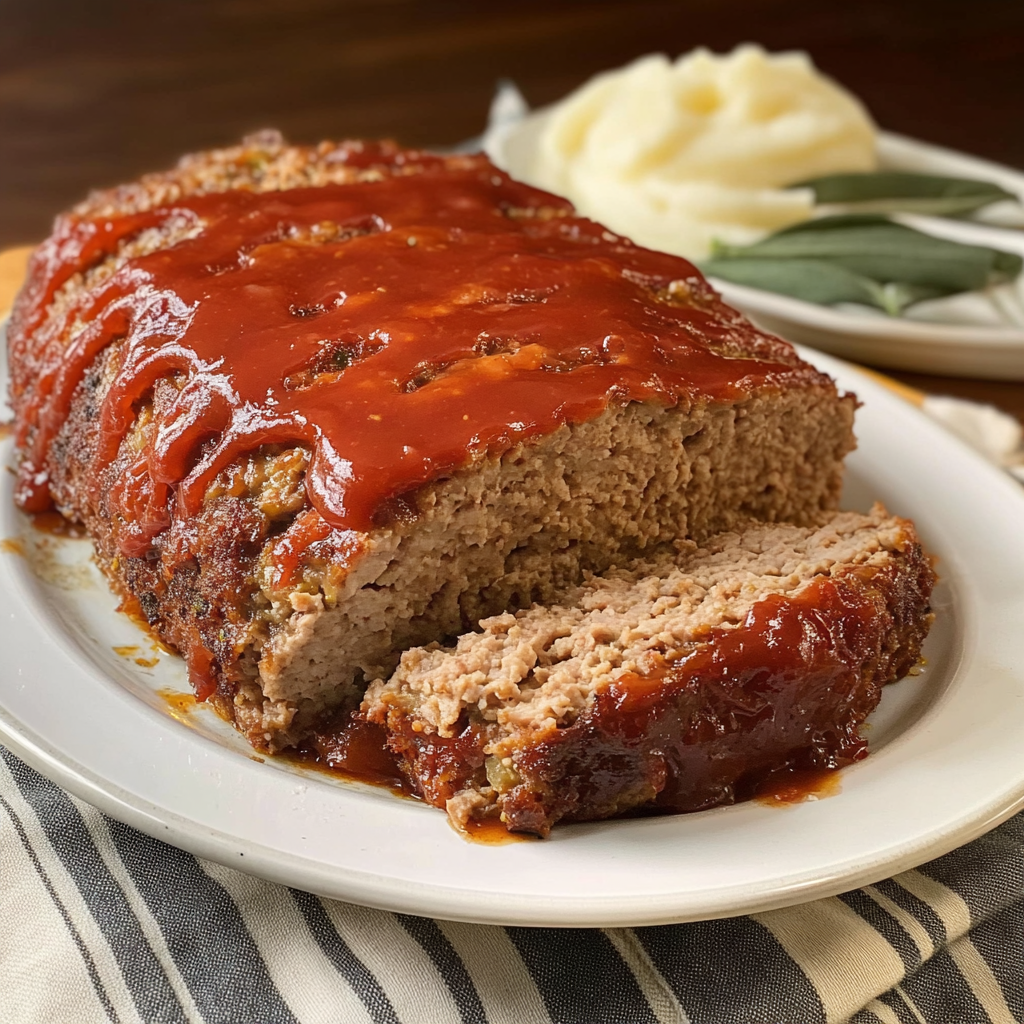The rich, savory aroma of this Classic Homestyle Meatloaf will instantly remind you of family dinners from childhood. With tender ground beef seasoned to perfection and topped with a sweet and tangy glaze, it’s the kind of comforting dish that fills both your belly and your soul.
This recipe delivers a hearty and satisfying meal without being complicated. Whether it’s a cozy Sunday dinner or a make-ahead weeknight solution, this meatloaf never disappoints. Serve it with creamy mashed potatoes and roasted vegetables for a timeless, crowd-pleasing plate of comfort.
Full Recipe
Ingredients:
-
1 ½ pounds ground beef (preferably 80/20)
-
1 small onion, finely chopped
-
1 cup milk
-
1 cup plain dry breadcrumbs
-
2 eggs, lightly beaten
-
2 tablespoons ketchup
-
1 tablespoon Worcestershire sauce
-
1 teaspoon salt
-
½ teaspoon black pepper
-
½ teaspoon garlic powder
-
½ teaspoon dried thyme
-
¼ teaspoon dried sage
For the Glaze:
-
½ cup ketchup
-
1 tablespoon brown sugar
-
1 teaspoon mustard (yellow or Dijon)
Directions:
-
Preheat oven to 350°F (175°C). Lightly grease a 9×5-inch loaf pan or line it with parchment paper.
-
In a large mixing bowl, combine ground beef, chopped onion, milk, breadcrumbs, eggs, ketchup, Worcestershire sauce, salt, pepper, garlic powder, thyme, and sage. Mix gently using your hands or a fork until just combined—do not overmix.
-
Press the meat mixture into the prepared loaf pan and smooth the top.
-
In a small bowl, whisk together the glaze ingredients: ketchup, brown sugar, and mustard. Spread evenly over the top of the meatloaf.
-
Bake uncovered in the preheated oven for 55-65 minutes, or until internal temperature reaches 160°F (71°C).
-
Let rest for 10 minutes before slicing. Serve with mashed potatoes, green beans, or your favorite sides.
Prep Time: 15 minutes | Cooking Time: 60 minutes | Total Time: 1 hour 15 minutes
Kcal: 375 kcal | Servings: 6 servings
The History of Meatloaf
Meatloaf is a true American classic that has stood the test of time. While it’s now commonly associated with mid-century comfort food, its origins stretch much further back, even into ancient Roman times. The earliest forms of meatloaf were a simple mix of ground meats and grains, prepared to stretch resources and prevent food waste. In the United States, meatloaf as we know it became popular in the 19th century, when meat grinders were becoming more common in households.
During the Great Depression, meatloaf served a very practical purpose—extending meat with fillers like breadcrumbs, oats, and milk helped families feed more mouths with fewer resources. Over time, it evolved from a survival meal to a staple of the American dinner table. It was featured in cookbooks, church potlucks, and school lunches, gaining a nostalgic hold over generations.
Why Meatloaf is the Ultimate Comfort Food
The enduring appeal of meatloaf lies in its comforting flavors, ease of preparation, and adaptability. It represents home cooking at its finest—simple, affordable, and satisfying. For many people, meatloaf evokes childhood memories of family dinners, school lunches, or grandma’s cozy kitchen. It’s one of those dishes that not only fills the stomach but warms the heart.
The aroma of a meatloaf baking in the oven, with its rich scent of herbs, onion, and garlic wafting through the kitchen, is enough to bring anyone to the table. The sweet and tangy tomato glaze on top, the soft texture inside, and the pairing with classic sides like mashed potatoes or green beans makes it a soul-soothing meal.
Customizing Your Meatloaf
What makes meatloaf so versatile is its ability to adapt to your personal taste and pantry ingredients. While the classic recipe features ground beef, onions, breadcrumbs, milk, and a tomato-based glaze, there are nearly endless ways to switch it up.
For those watching their red meat intake, ground turkey or chicken can be used as leaner alternatives. Want a richer flavor? A mix of ground pork and beef offers excellent depth. If you’re aiming for a more gourmet twist, consider adding sautéed mushrooms, finely grated carrots, or even crumbled blue cheese for an extra flavor boost.
Spice lovers can add hot sauce, red pepper flakes, or chipotle powder to give the dish a kick. Alternatively, swap out the traditional ketchup glaze for barbecue sauce, honey mustard, or a balsamic reduction. For a gluten-free version, use gluten-free breadcrumbs or rolled oats in place of traditional ones.
Tips for Making the Perfect Meatloaf
While meatloaf is a relatively easy recipe to master, a few tips can elevate it from good to great. First, be careful not to overmix your ingredients. Overworking the meat can lead to a dense, tough loaf. Use your hands or a fork and mix just until everything is combined.
Secondly, let your meatloaf rest for at least 10 minutes after baking. This allows the juices to redistribute, resulting in a moister final product. Skipping this step could leave you with a dry or crumbly loaf when you slice it.
Don’t underestimate the importance of the glaze. The sweet-savory topping not only enhances the flavor but also creates a beautiful caramelized layer that makes each bite more enjoyable. Brush it on halfway through baking for a glossy finish.
Finally, consider using a baking sheet instead of a loaf pan. Shaping the loaf by hand on a sheet pan allows the fat to drain away and gives you more surface area for caramelization. Plus, it’s easier to tell when the meatloaf is done cooking evenly.
Serving Suggestions
Classic meatloaf pairs beautifully with traditional side dishes. Creamy mashed potatoes and green beans are the go-to, offering a familiar and comforting balance of textures and flavors. However, the side options are nearly endless.
For a Southern flair, serve your meatloaf with mac and cheese, collard greens, or cornbread. If you’re going for a lighter meal, try roasted root vegetables, a crisp garden salad, or sautéed zucchini ribbons.
Leftover meatloaf also makes excellent sandwiches. Thick slices between toasted bread, with a bit of mayo, lettuce, and tomato, create a next-day lunch that rivals any deli order. You can also crumble leftover meatloaf into pasta sauces or chili to reduce waste and stretch your meal even further.
Cultural Variations of Meatloaf
Though considered a staple of American cuisine, many cultures have their own version of meatloaf. In Germany, Falscher Hase is a traditional meatloaf made with boiled eggs in the center. In Italy, Polpettone is often stuffed with vegetables, cheese, and herbs. Meanwhile, in the Philippines, a dish called Embutido uses ground pork and is typically wrapped in foil and steamed instead of baked.
These international renditions show the global love for this humble dish and how its basic formula—ground meat, seasonings, and filler—can be endlessly adapted to local tastes and traditions.
Why This Classic Recipe Works
This particular old-fashioned meatloaf recipe hits all the right notes. It’s based on decades of home-cooked tradition, with thoughtful ingredients chosen for maximum flavor and moisture. Milk softens the breadcrumbs, ensuring a tender texture. Eggs act as a binder, and the classic mix of herbs like thyme, sage, and garlic powder adds a warm depth.
The glaze—sweet, tangy, and just a bit sharp from mustard—balances the savory richness of the beef. It’s this harmony of flavors that makes each bite satisfying without being overly heavy. The proportions in this recipe have been perfected to create a meatloaf that’s easy to slice, never dry, and always delicious.
Meatloaf for the Modern Home Cook
Today’s home cooks are busier than ever, but that doesn’t mean you have to sacrifice quality or flavor. Meatloaf is a forgiving, make-ahead dish that stores well in the fridge or freezer. You can prepare the mixture a day in advance, store it in the loaf pan, and bake it fresh when needed.
It also reheats beautifully—whether in the oven, air fryer, or microwave—making it a solid choice for meal prep. And with its affordability and the ability to serve several people, it’s a great option for budget-conscious households.
Conclusion
The enduring appeal of meatloaf lies in its balance of simplicity, heartiness, and comfort. It’s one of those dishes that brings people together, whether it’s a casual weeknight dinner, a cozy weekend meal, or a nostalgic nod to childhood. This classic version celebrates the tradition of meatloaf while offering enough flexibility to make it your own.
Whether you serve it with mashed potatoes and gravy, or pack the leftovers for tomorrow’s sandwich, this meatloaf is more than just a meal—it’s a warm hug on a plate. So the next time you’re craving something hearty and homemade, turn to this timeless favorite. One bite, and you’ll understand why it’s stayed in our hearts—and kitchens—for generations.






